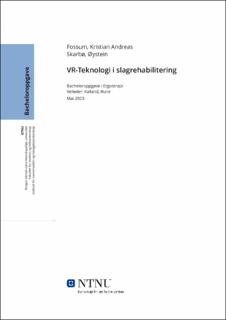| dc.contributor.advisor | Kalland, Rune | |
| dc.contributor.author | Fossum, Kristian Andreas | |
| dc.contributor.author | Skarbø, Øystein | |
| dc.date.accessioned | 2023-06-30T17:21:07Z | |
| dc.date.available | 2023-06-30T17:21:07Z | |
| dc.date.issued | 2023 | |
| dc.identifier | no.ntnu:inspera:144848408:147258842 | |
| dc.identifier.uri | https://hdl.handle.net/11250/3074893 | |
| dc.description.abstract | Mål og Hensikt: Hjerneslag er hovedårsaken til funksjonshemming i Norge, og om lag 11 000 nye tilfeller skjer hvert år. Dette problemet vil sannsynligvis vokse etter hvert som andelen eldre befolkning i landet fortsetter å stige. Tidligere forskning etterspør mer forskning på hvordan Virtuell virkelighet oppleves benyttet i rehabilitering. Vi har derfor i denne litteraturstudien utforsket studier som inkluderer pasientens erfaringer med Virtuell virkelighet i slagrehabilitering, samt deres perspektiver på hvordan teknologien kan påvirke deltakelse i Activities of Daily Living.
Metode: Tre databaser ble gjennomsøkt etter relevante studier publisert i spennet fra 2015 til 2023. Fem studier ble inkludert i denne bacheloren, som er inspirert av scoping review som metode og rammeverk. Studiene ble analysert gjennom en forenklet tematisk analyse.
Resultater og konklusjon: Tre hovedtemaer kom frem av analysen; 1) VR-opplevelsen, 2) Barrierer og 3) Opplevd påvirkning på funksjon. Under 1) VR-opplevelsen ble tre underkategorier identifisert; a) Motiverende og engasjerende, b) Mulighet for tilpassing, og c) Tilbakemelding.
Gjennom diskusjonen diskuteres pasientens erfaringer med teknologien opp mot tidligere forskning, MoHO, det dynamiske samspillet, samt politiske føringer.
På tross av barrierene som er identifisert, oppleves teknologien å være en motiverende og engasjerende måte å bli rehabilitert på for pasienten. Virtuell virkelighet oppleves å gi muligheter for tilpassing, noe som legger til rette for deltakelse i rehabilitering.
Denne bacheloren konkluderer med at Virtuell virkelighet som rehabiliteringsmetode erfares som en trygg, engasjerende og motiverende måte å rehabiliteres på. Det er også erfart å ha innvirkning på deltakelse i Activities of Daily Living. Ytterligere forskning på hvordan Virtuell virkelighet oppleves å påvirke deltakelse i Activities of Daily Living kan være av interesse. Eventuelt kan forskning rundt hvordan Virtual Reality fungerer som telerehabilitering også være nyttig.
Nøkkelord: Stroke, Virtual Reality, Rehabilitation, Activities of Daily Living, Participation | |
| dc.description.abstract | Aims and Objectives: Stroke is the main cause of disability in Norway, about 11 000 new cases happen every year. This issue will probably grow as the percentage of elderly population in the country continues to increase. Past research inquires more research on how Virtual Reality is experienced and used in rehabilitation. Therefore, in this study, we have explored studies that include the patients perspectives on Virtual Reality in stroke rehabilitation, as well as their perspectives on how the technology can affect participation in Activities of Daily Living.
Method: Three databases were searched for relevant studies published in the span from 2015 to 2023. Five studies were included in this bachelor, which is inspired by the method scoping review, depending on the inclusion criteria. The studies was analysed through a simplified thematic analysis.
Results and Conclusion: Three main themes arose from the analysis; 1) The VR Experience, 2) Barriers, and 3) Percieved impact on function.
Under 1) The VR experience, three subcategories was identified; a) Motivating and engaging, b) Possibility for Adjustment, and c) Feedback.
The technology is generally experienced by the patient as a motivating and engaging way of rehabilitation. VR is experienced to have opportunities for adjustment, which facilitates participation in rehabilitation. Allthough several advantages are recognized, barriers are also identified - such as technological malfunctions and lack of experience with technology.
This bachelor concludes that Virtual Reality as a rehabilitation method provides a safe, engaging and motivating way of rehabilitation. It´s also experienced to have an impact on participation in Activities of Daily Living. Further research upon how Virtual Reality is experienced to affect participation in both Activities of Daily Living as well as participation as a whole, could be of interest. VR as telerehabilitation is also a aspect that could be of interest for further research.
Keywords: Stroke, Virtual Reality, Rehabilitation, Activities of Daily Living, Participation. | |
| dc.language | nob | |
| dc.publisher | NTNU | |
| dc.title | VR-Teknologi i slagrehabilitering | |
| dc.type | Bachelor thesis | |
